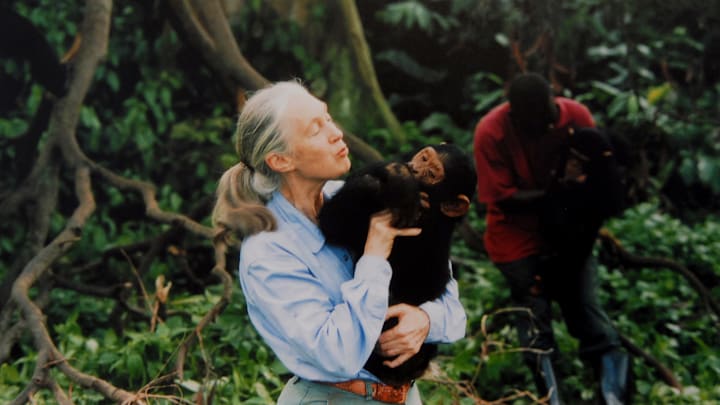Jane Goodall, whose death was announced on October 1, 2025, was still a young woman when her research changed the course of scientific history. Of her discovery that chimpanzees make and use tools—an ability previously believed to belong only to humans—paleoanthropologist Louis Leakey famously said, “Now we must redefine ‘tool,’ redefine ‘man,’ or accept chimpanzees as humans.”
Her work and legacy loom large among animal lovers. Below, discover eight fascinating facts about the accomplished primatologist.
- A stuffed animal changed her life.
- She started her research without a degree.
- But she wound up with plenty of degrees ...
- ... Among other titles.
- Her work rubbed a lot of people the wrong way.
- Stevie Nicks wrote a song about Jane Goodall.
- You might have seen Jane Goodall in cartoon form.
- She worked until the end.
A stuffed animal changed her life.

Jane met her first chimpanzee on her first birthday. From that day forward, the stuffed ape named Jubilee accompanied the little girl on all her adventures, inspiring the love of animals that would one day shift our views on animal intelligence.
Decades later, Goodall gave talks on animal welfare with the assistance of a stuffed monkey named Mr. H and a cow named Cow, both gifts from her fans. “Cow has worked really hard,” Goodall told Mosaic. “She has created I don’t know how many vegetarians.”
She started her research without a degree.

Goodall’s first steps into Gombe Stream National Park in 1960 were extraordinary for many reasons. The 26-year-old was only the second researcher to attempt to study chimpanzees in the wild, and she had no one with her aside from her mother and an assistant. She also had no formal scientific training—a fact that likely enabled her many breakthroughs. Unbound by preconceived notions of what animal research should be, the young scientist got close to her subjects, sat down, and paid attention.
You Might Also Like ...
- Jane Goodall is Getting the Barbie Treatment—With a Doll Made of Recycled Plastic
- 9 Amazing Facts About Chimpanzees
- 7 Animal Welfare Organizations to Support
Add Mental Floss as a preferred news source!
But she wound up with plenty of degrees ...
Goodall became Dr. Goodall in 1966 when she received her Ph.D. in ethology (animal behavior) from the University of Cambridge. After that, she earned more diplomas than most walls could hold, with honorary degrees from nearly 40 universities in 15 different countries.
... Among other titles.

Dr. Goodall was also a Dame Commander of the Order of the British Empire, a UN Ambassador for Peace, and the recipient of countless awards and honors for her scientific, humanitarian, and animal welfare work. For a brief period, during her marriage to wildlife photographer Baron Hugo van Lawick, she was also Baroness Jane van Lawick-Goodall. She was awarded the Presidential Medal of Freedom in January of 2025.
Her work rubbed a lot of people the wrong way.

Historically, the scientific establishment has not taken kindly to upstarts and outsiders. Or women, for that matter. In the beginning, many established researchers held Goodall’s unusual approach and lack of university pedigree against her. They found her methods soft and problematic—Goodall named her research subjects instead of giving them ID numbers, which caused a scandal—and some went so far as to suggest that the tool-using chimps had been trained. Over time, her body of research grew so compelling that her supporters outnumbered her detractors.
Stevie Nicks wrote a song about Jane Goodall.
Nicks debuted the song in 1991. “I met Jane in Dallas at the end of 1991. I came back, got all her books and I was just so impressed. She was a lot like me when she was young. She definitely was going to be devoted to something and so was I. I think that some kids are like that and some aren’t. We were both diligently looking for something to devote our lives to—and we both found something.” the singer wrote.
You might have seen Jane Goodall in cartoon form.
In the 2001 Wild Thornberrys episode “The Trouble With Darwin,” Goodall appeared, as herself, to help Eliza save chimpanzees from greedy poachers.
She worked until the end.

Goodall returned from the field in the 1980s, but her life’s work had barely begun. For decades after, she was on the road more than 300 days a year, giving talks and leading initiatives to improve the lives of chimpanzees, apes, and all animals in captivity and in the wild. She died while in California while on one of her speaking tours. She was 91 years old.
A version of this story originally ran in 2017; it has been updated for 2025.
